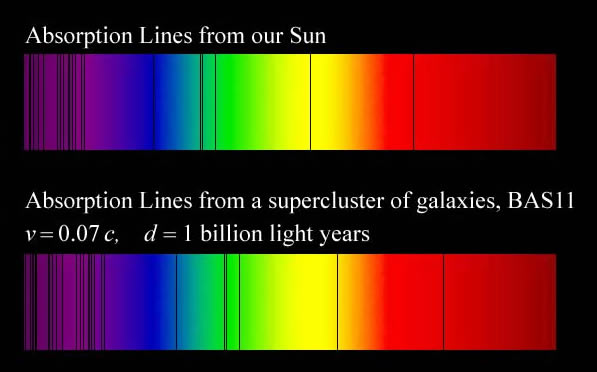The Big Bang
The Big Bang theory states that the universe began when an extremely small, non-dimensional point containing all of the mass and energy of our current universe, called a singularity, began to spontaneously expand roughly 13 billion years ago.
Although you may think that it is impossible for scientist to know what happened 13 billion years ago or you may think that the Big Bang theory sounds ridiculous the theory, as all scientific theories, is based in fact and recorded observation. As you will see throughout this semesters understanding the past (no matter how long ago) simply requires your understanding of the properties and processes that operate within our world and the ability to understand how those processes effect the world around us.
In the early 1920's while observing the spectrum produced from the light of distant galaxies, Edwin Hubble noticed that the wavelengths of light seemed to be shifted toward the red side of the spectrum. Spectrum are produced when the individual wavelengths (colors) that make up visible light are spread out according to their wavelength--violet light, with a very short wavelength, on the left and red, with a very long wavelength, on the right.
Unlike the continuous spectrum that you might see in a rainbow, the spectrum from stars and galaxies have thin dark vertical lines, called absorption spectra. These lines are caused when certain wavelengths (colors) of light are absorbed by chemical elements within the star or galaxy. Since the light is absorbed it is not given off by the star and those colors (wavelengths) are not visible in the spectrum.
 |
| Comparison of spectra. Top spectrum showing solar absorption lines. Bottom spectrum from distant galaxies. |
In the image to the right two spectrum, one from our sun and the other is from light from distant galaxies. Notice how the absorption bands in the spectrum from the distant galaxies are and our Sun have same pattern yet those of the distant galaxies appear to be shifted to the right (towards the red side of the spectrum). This shift is what scientist call a red shift.
In 1929 Hubble suggest that the shift seen in the spectra of distant galaxies was a result of the Doppler Effect. The doppler effect describes what happens to the apparent wavelength of sound as a result of movement.
